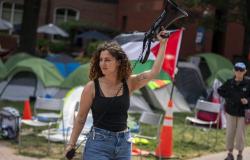After important restoration and arrangement works, it is now possible to return to visit the Mussolini’s bunker at Villa Torlonia in Rome and the Air-raid shelter. The two underground structures located beneath the Casino Nobile have been reopened to the public since April 5th new multimedia setup which allows for an immersive and experiential visit. But let’s see what the new visit route consists of.
The two structures have now been reopened to the public thanks to the commitment of Roma Capitale, Department of Culture – Capitoline Superintendence of Cultural Heritage. The project is curated by Federica Pirani and Annapaola Agati. Museum organization and services by Zètema Progetto Cultura. The historical memory of the Bunker, which recalls one of the darkest and most dramatic pages of the city which was hit by 51 aerial bombings between July 1943 and May 1944, was reconstructed through a photographic and audio-visual setup favoring the story and re-enactment of the past through sounds and images.
The Bunker and the Air Raid Shelter can be accessed exclusively with a guided tour by booking on the website of the Museums of Villa Torlonia and the Museums in the Municipality of Rome, or directly at the ticket offices of the Casino Nobile, the Serra Moresca and Technotown.
The history of the Bunker and the Air Raid Shelter
The realization of Mussolini’s bunker at Villa Torloniaclosed from 2021, and of Air-raid shelter dates back to the 1940s. In fact, between 1929 and 1943, Villa Torlonia was the private residence of Benito Mussolini and his family. With Italy’s entry into the war and the first bombings, three underground structures were built in the villa in 1940 to protect the then head of government from possible aerial bombings.
The Air-raid shelter it was built in 1941 in the basement of the building and used in 1942 and 1943. The rooms, reinforced with a thickness of 120 centimeters of reinforced concrete, were equipped with anti-gas doors and an air purification and exchange system.
The construction of Bunker it began in December 1942, for an expected amount of 240,000 lire, a figure which was then doubled, having to deepen the excavation for the foundations and dismantle a pre-existing underground corridor that connected the Tribuna with Fontana with a secret room, commissioned by Alessandro Torlonia. The structure remained unfinished since on 25 July 1943, when Mussolini was arrested, it had not yet been completed.
The Bunker is located under the square in front of the Casino Nobile, at a depth of six metres. It has a cross-shaped plan with two emergency exits (one on the side square of the Casino and another inside the Grandstand with Fountain) and with galleries 15 meters long with a circular section with a diameter of 2.50 meters, protected by a 4 meter thick reinforced concrete wall. At the time of the interruption of construction work, watertight doors, forced ventilation machines and bathrooms were still missing.
The new multimedia setup aims on the one hand to provide historical-documentary information on Rome during the Second World War and on Mussolini’s choice to make Villa Torlonia his residence in the city, on the other to offer visitors an immersive journey that will lead them to perceive the experience an air attack inside an underground shelter.
But how does it unfold new visit route? Going down the stairs that lead from the rooms of the Casino Nobile to the basement of the building, you pass a break that is not only architectural: on the one hand air, light, beauty, on the other darkness, humidity and a feeling of constriction. The route, conceptually divided into three parts, winds through the basement to the Bunker, from which, through a long corridor, you exit into the park.
Mussolini’s life at Villa Torlonia
The visit begins with a video that tells, through historical photos, the life of Mussolini and his family at Villa Torlonia: parties, official ceremonies, tennis matches, horse riding exercises. With Italy’s entry into the war, the need arose to protect the Duce from possible air attacks and the construction of the shelters and the Bunker began. In the following rooms, through newsreels of the time, the historical period of the bombings of Rome is recalled, in particular those on the San Lorenzo district. In addition to projections of historical documents, the exhibition makes use of the presence of photographic collages that appear as if printed directly on the walls.
Life in shelters
The three rooms that follow are connected to each other by a series of synchronized projections that reconstruct in an immersive and engaging way episodes of what life must have been like inside an air raid shelter during a bombing.
The bombed city
A series of projections describes the double perspective of those who bomb from above and do not perceive the effects and of those below who suffer the consequences. On the floor flow images of Rome seen from planes in flight, during a bombing, while the city in rubble is projected on the walls.
The Bunker
Through a steep staircase, you access the last stage of the route: the actual bunker which is 6 meters deep. Its large cylindrical structure was deliberately left free from objects or projections to enhance its structural quality. In this space an air raid is simulated, through the reproduction of sounds (sirens, approaching planes, detonations) and ground vibrations.






